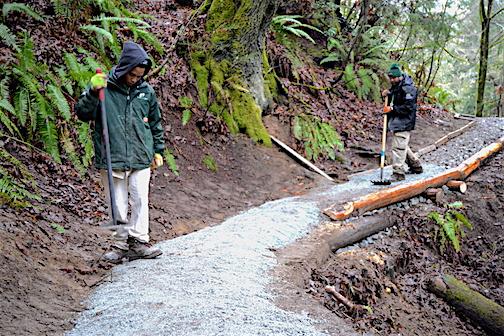Area resident critical of Schmitz Preserve Park improvements
Schmitz Park improvements have not pleased everyone.
Wed, 01/06/2016
By Lindsay Peyton
Ken Shaw calls it “an act of vandalism” – the city’s addition of rock to trails at Schmitz Preserve Park, located at 5551 SW Admiral Way, just down the street from his house.
“It’s the wildest landscape in the city,” he said. “They disrespect the park as a standard practice.”
Shaw believes that covering the trails with rock may hide faults lying underneath – and that those problems will rise to the surface again eventually. “It’s creating a situation where more work will have to be done,” he said.
And he has a problem with the manner in which the work on the trails is being conducted.
“They come into the trail system, off-load a truck right on the trail, blocking the trail,” he said. “They shouldn’t even be driving on the trail. Just getting there, they’re doing damage to the park. It does nothing but weaken what we have.”
Shaw has been volunteering in the park alongside his neighbors for the past 20 years – removing litter, clearing trails and weeding invasive species of plants.
“We want the place to be as natural and native as possible,” he said. “We want to do the least intervention so we can do the least damage.”
He is concerned that the city does not share the vision that many area residents have for the park. “They just make it worse,” he said. “The trails are always in upheaval. They’re doing modifications on the forest based on bad information.”
Chukundi Salisbury, trails coordinator for Seattle Parks and Recreation, said he has received both complaints and praise from park users.
“The construction, while a current inconvenience and eyesore for some, will result in the preservation of the green space by keeping users on the trail in the future,” he said. “It may be an eyesore for 30 days, but the upgrades will last for the next 30 years.”
He said that by adding the rock to the trail, hikers, runners and pedestrians will be able to avoid trekking through mud and will have easier access to the park.
“We want better, well-maintained trails that look inviting – which often results in more use of the park,” Salisbury said.
He explained that the standards of trail maintenance are created with the amount of park users in mind.
“As the entire city becomes denser – and more and more people move here – it’s incumbent that we maintain the green space while allowing sustainable and responsible use,” he said. “We’re trying to balance preservation of the green space, and we’re also trying to deal with the influx of users.”
The parks department recently installed an “eco-counter” to collect numerical data at the preserve, recording the number of passer-bys on certain trails. In less than one month on one trail at one entrance, Salisbury said 2,200 visitors were counted. He anticipates that number will only continue to rise.
“That was the traffic during the wettest month in the city,” he said. “That will grow exponentially in the summer. When you look at the data, it supports what we’re doing. We need to be responsible to the silent majority.”
Salisbury said a team of landscape architects and engineers developed the standards for the city parks.
“Based on the amount of trails we have and the amount of people using them, we want to build to a degree that it will last a long time,” he said. “It’s for the greater good of the park. We have to anticipate the amount of people who are coming. We know that people are moving here. It’s not the West Seattle of 40 years ago.”


